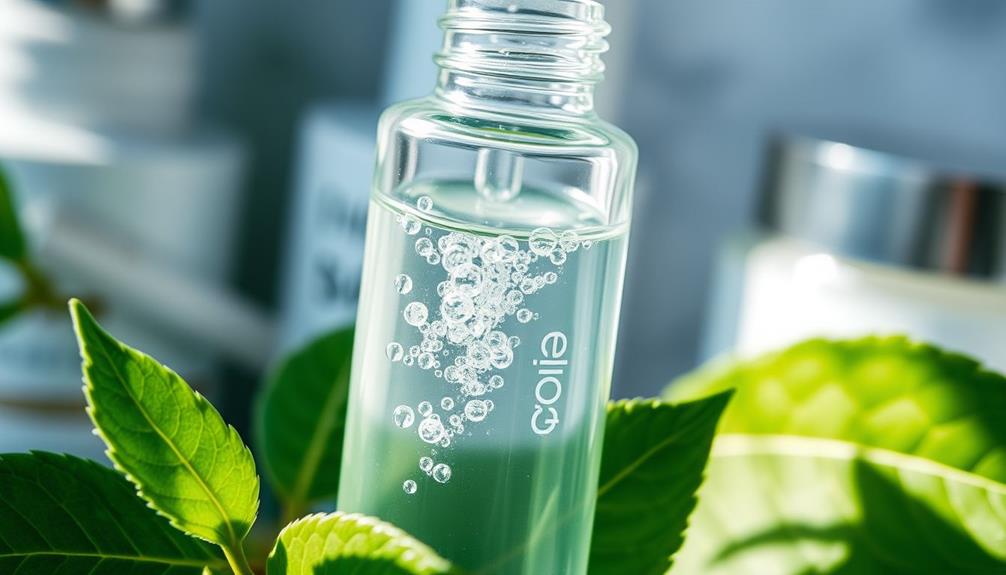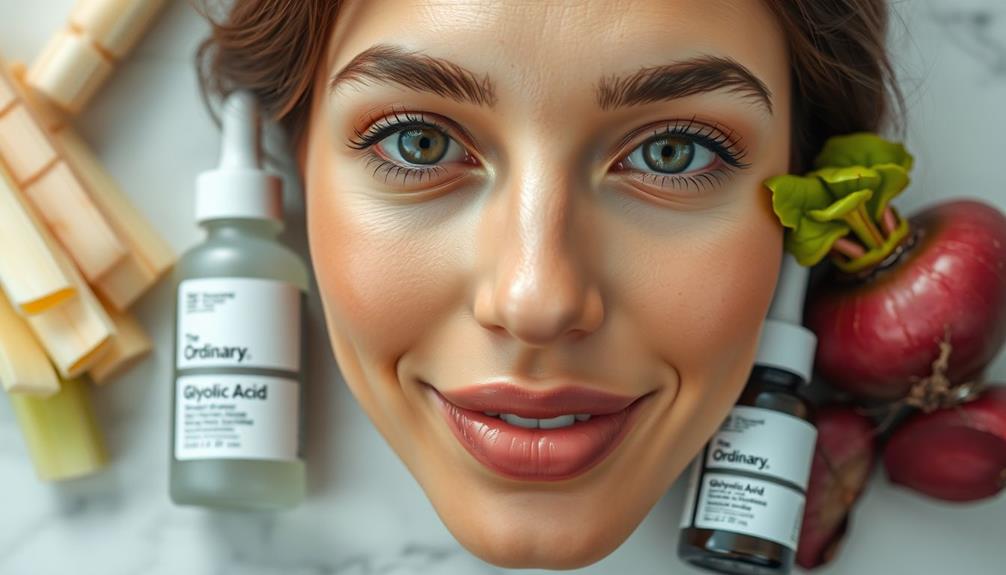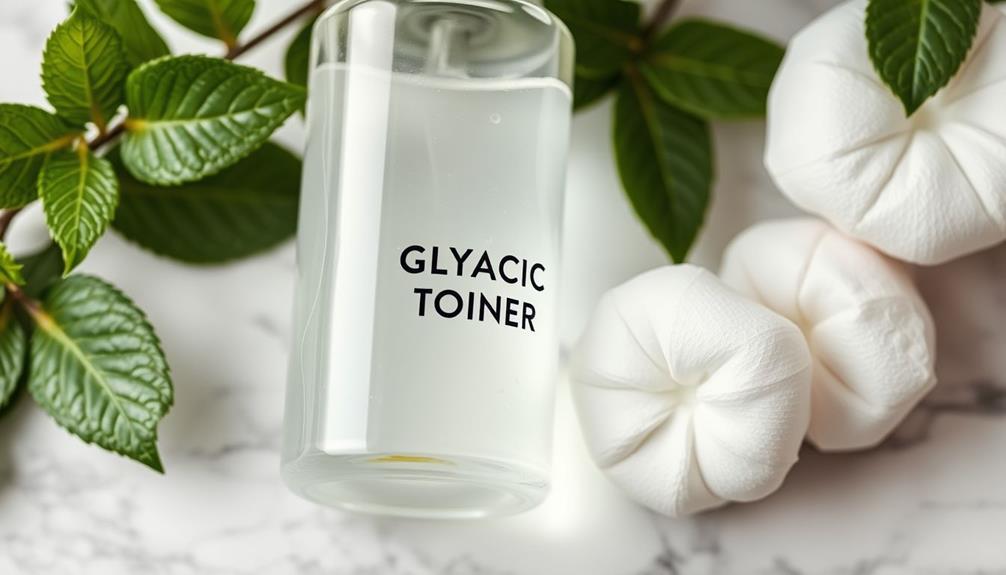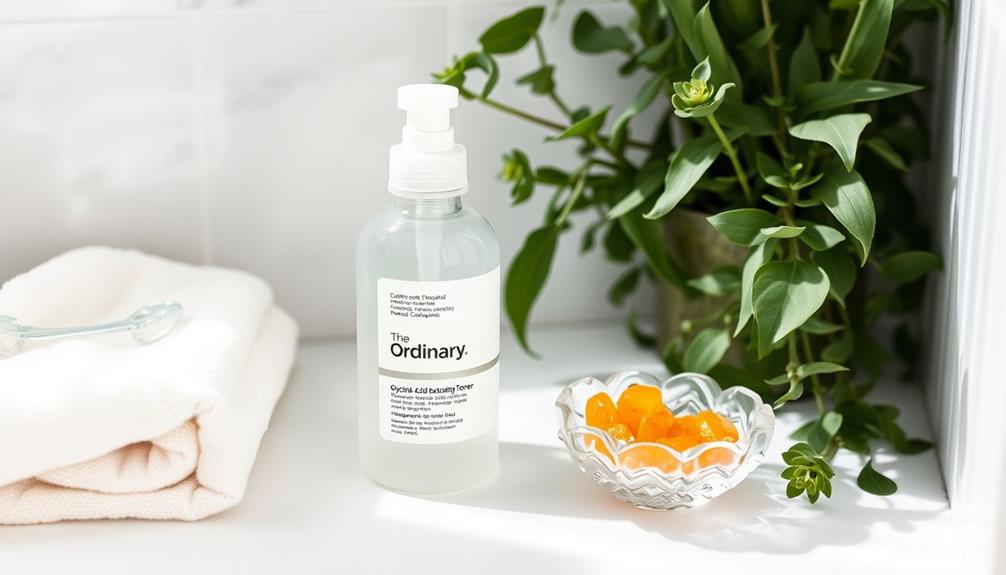Glycolic acid is a fantastic ingredient for your feet as it helps to smooth and soften rough skin. It exfoliates gently, getting rid of dead skin cells, and its humectant properties help to bring moisture into your skin. Products containing 15%-20% glycolic acid can make a significant difference in the texture and hydration of your feet. Consistent use of glycolic acid foot creams or toners can reduce dryness and cracked heels, leaving your feet feeling revitalized. It’s important to follow up with a moisturizer for maximum hydration. By establishing a proper routine, softer feet can be achieved quickly, with so much more to learn about improving your foot care.
Key Takeaways
- Glycolic acid effectively exfoliates dead skin cells, promoting smoother and softer feet by breaking down bonds between hardened skin.
- Its small molecular size allows for deep penetration, enhancing moisture absorption and hydration in the skin.
- Regular use of glycolic acid foot creams minimizes hyperkeratosis, leading to improved skin texture and comfort.
- Incorporating glycolic acid into foot care routines can significantly reduce roughness and flakiness within weeks.
Understanding Dry Skin on Feet
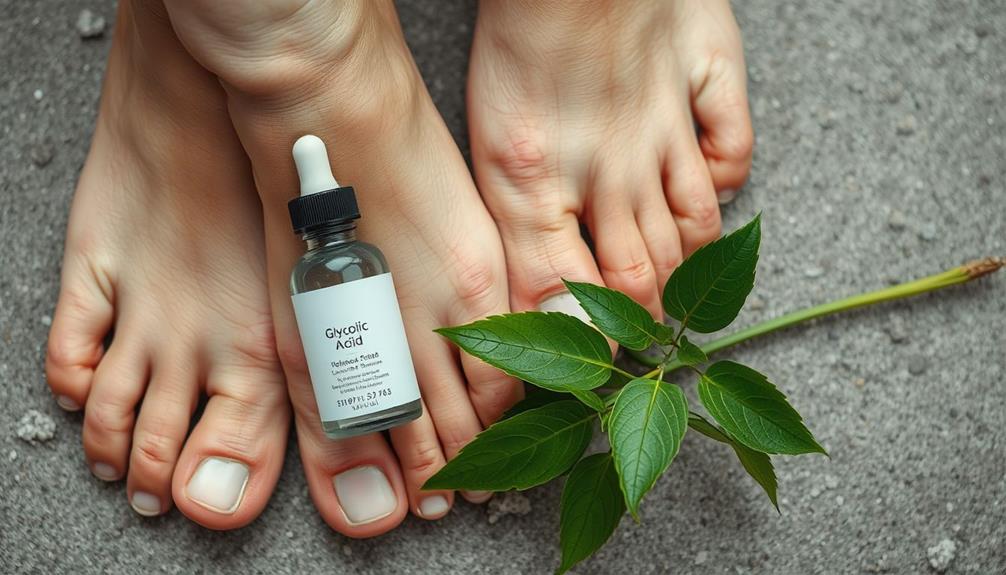
Understanding dry skin on your feet starts with recognizing the common causes, like harsh soaps and cold weather, that strip away essential moisture. Factors such as poor circulation and lack of proper hydration can also contribute to dryness.
When your skin loses hydration, it can lead to rough texture, flakiness, and discomfort, impacting both aesthetics and comfort. One of the most noticeable effects of untreated dry skin is cracked heels, which can become painful and increase the risk of infections if not addressed.
To combat dry skin, regular moisturizing is vital. Applying a rich foot cream daily helps lock in moisture and keeps your skin supple.
Additionally, exfoliation should be part of your routine; removing dead skin cells can prevent buildup that contributes to dryness. Consider incorporating glycolic acid into your regimen. This ingredient aids in gentle exfoliation, promoting smoother skin while enhancing the absorption of your moisturizer.
You might also explore essential oils for skin nourishment to further improve the health of your feet.
Benefits of Glycolic Acid
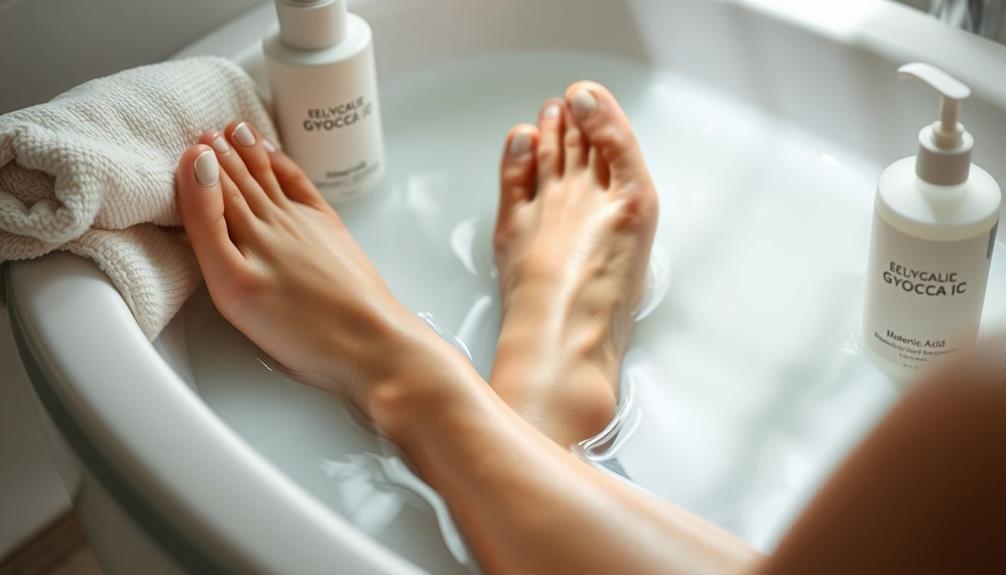
Incorporating glycolic acid into your regimen offers remarkable advantages. First, its powerful exfoliation helps break down the bonds between dead skin cells, resulting in smoother, softer feet. This is similar to how ginger aids in digestion by breaking down food in the stomach, showcasing the importance of breaking down barriers for improved results. If you're dealing with rough or cracked skin, regular use can greatly reduce hyperkeratosis, preventing discomfort and enhancing overall texture.
Another key benefit is hydration. Glycolic acid acts as a humectant, drawing moisture from the environment into your skin. This means that not only does it promote soft skin, but it also combats dryness effectively, keeping your feet feeling pampered and moisturized. With its small molecular size, glycolic acid penetrates deeply, maximizing hydration and rejuvenation.
Using glycolic acid products with concentrations between 15% to 20% is particularly effective for foot care, as these levels are more potent than those typically used for facial treatments. This potency guarantees that you'll see substantial improvements in the condition of your feet, making them softer and more resilient.
Recommended Glycolic Acid Treatments
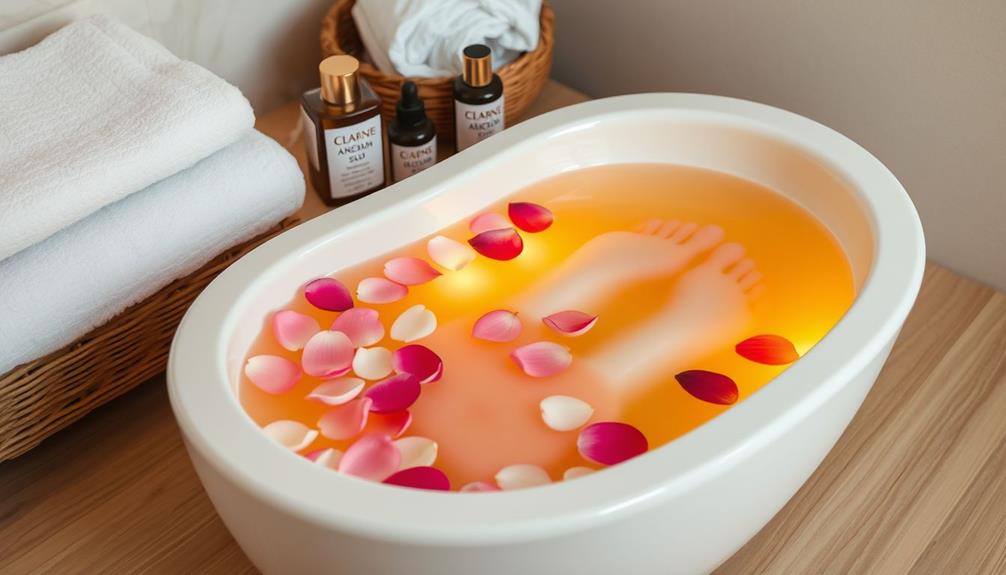
When it comes to choosing glycolic acid treatments for your feet, several effective options can help you achieve smoother, healthier skin. Incorporating essential oils for added benefits can further enhance your foot care routine.
Here's a list of recommended products that target dead skin cells and enhance your foot care routine:
- Glycolic Acid 7% Toning Solution: A popular exfoliant that helps remove dead skin cells and improves skin texture.
- CeraVe SA Renewing Foot Cream: This foot cream combines glycolic acid with moisturizing ingredients to hydrate and soften your skin.
- Glycolic Peel Cleansing Pads: Convenient and easy to use, these pads provide an intensive exfoliation treatment.
- Ultra Anti-Aging Cream: Use this after the cleansing pads for enhanced moisturization and smoother results.
Incorporating these glycolic acid foot treatments into your routine can greatly enhance the appearance and feel of your feet. Remember to follow each treatment with proper moisture for the best results.
Post-Treatment Care Tips
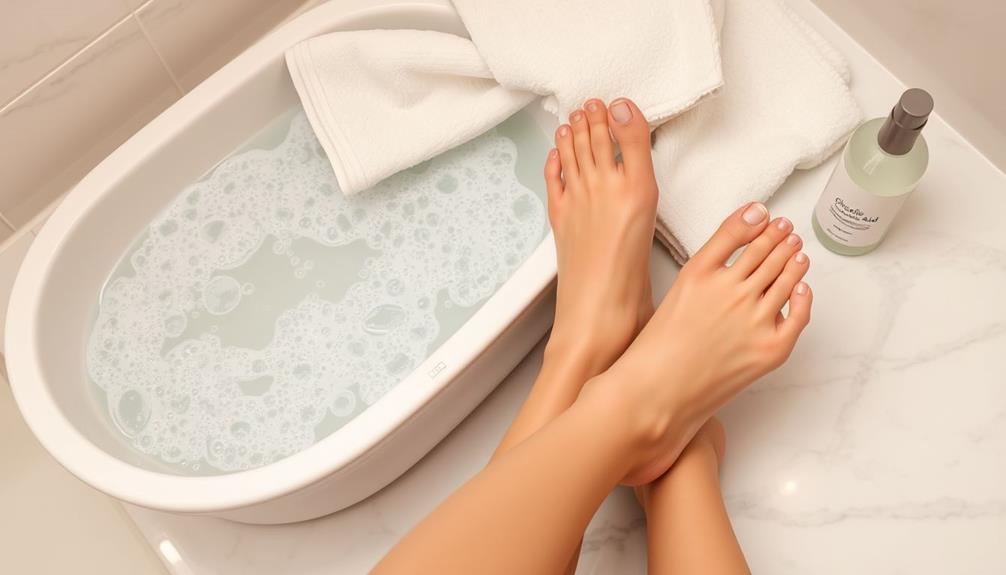
After applying glycolic acid treatments, it's crucial to follow specific care tips to guarantee your feet stay comfortable and hydrated during the peeling process. Here are some important steps to make certain effective post-treatment care:
| Tip | Details |
|---|---|
| Wear Comfortable Shoes | Opt for shoes that provide support and cushioning to prevent blisters. |
| Keep Feet Hydrated | Daily lotion application helps retain moisture and maintains the improved skin barrier. |
| Allow Feet to Breathe | Whenever possible, choose open shoes to enhance air circulation and moisture retention. |
During the peeling process, be cautious to avoid slipping. Shoes with grips are advisable to promote stability. You'll notice the benefits of smoother, softer skin as you follow these care tips. Remember, the key to successful post-treatment care is consistent hydration and comfort. By taking these steps, you'll maximize the effects of glycolic acid and promote healthy feet.
Accessibility of Glycolic Acid Products
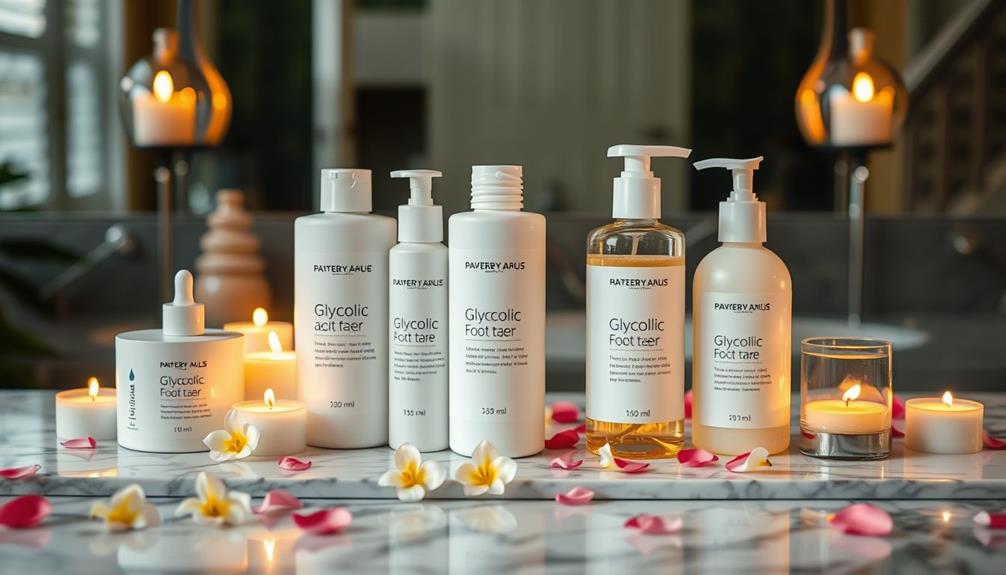
Glycolic acid products are easily accessible in various forms, making it simple for you to find the right option for your foot care routine. You can choose from a range of affordable skincare products that suit your needs, ensuring that smooth and soft feet are within reach. Incorporating mindful practices into your foot care can enhance results, as stress management techniques can improve overall well-being.
- Cleansers: Gently exfoliate while cleansing your feet.
- Toners: Balance and prep your skin for further treatment.
- Creams: Provide hydration and softness to dry, cracked skin.
- Peels: Offer targeted treatment for tougher areas.
Many of these glycolic acid options are available at prices ranging from £7.49 to £11.50, making them budget-friendly choices. You can easily find these products at pharmacies and online retailers, enhancing their accessibility.
The growing popularity of glycolic acid in skincare has led to an increase in formulations, allowing you to choose from different concentrations tailored specifically for foot care. With regular use, these affordable products can greatly improve the texture and hydration of your feet, helping you achieve that desired softness.
Popular TikTok Trends and Hacks

You've probably seen those viral TikTok hacks showcasing how glycolic acid can transform your feet.
With trending products making their rounds and experts weighing in, you might wonder what really works.
Many pet owners, for instance, have learned to be mindful of their cats' body language, which can reveal the importance of self-care routines, just as regular grooming is essential for maintaining a cat's health and emotional well-being understanding a cat's body language.
Let's break down these popular trends and the insights they bring to foot care.
Viral Foot Care Hacks
TikTok is buzzing with foot care hacks, especially the trending use of glycolic acid to achieve smoother, softer skin on your feet. With over 5.7 billion views on related discussions, users are sharing impressive results in combating dry cracked feet.
Influencer @calistatee recently demonstrated the power of The Ordinary's Glycolic Acid 7% Toning Solution, showcasing significant improvements within just two hours. Incorporating yoga for back pain relief can enhance overall body care, complementing your foot treatment routine by promoting better posture and circulation.
Here are some top foot care hacks making waves on TikTok:
- Use facial glycolic acid products on your feet for effective results.
- Apply glycolic acid before bed, then wear socks overnight for maximum absorption.
- Exfoliate with a foot scrub after glycolic acid application for extra smoothness.
- Follow up with a rich moisturizer to lock in hydration.
Dermatologists are on board with this TikTok trend, recognizing the legitimate benefits glycolic acid offers for smoothing and hydrating dry, cracked feet. Users are experiencing substantial improvements, making these hacks a must-try for anyone seeking smoother feet.
Trending Products Showcase
A variety of trending products have emerged from TikTok, showcasing innovative ways to enhance foot care routines and achieve smoother skin. One standout is The Ordinary's Glycolic Acid 7% Toning Solution. Users rave about its effectiveness, applying it before bedtime, followed by a moisturizer and a pair of socks for ideal results. This simple hack helps you see significant improvements in skin softness and texture in just hours.
TikToker @calistatee has popularized this method, even getting endorsements from the brand's CEO for its ability to create sandal-ready feet. Beyond glycolic acid, other products like Flexitol Rapid Revive Overnight Cream and CeraVe SA Renewing Foot Cream have also gained traction, praised for their complementary effects on dry, cracked skin.
The trend encourages you to think outside the box by repurposing facial glycolic acid products for foot care. By integrating these items into your skincare routine, you can enjoy a broader approach to foot care without the need for multiple products.
With these TikTok-inspired hacks, you'll transform your feet into a softer, smoother version of themselves in no time.
Expert Validation Insights
Numerous dermatologists endorse the use of glycolic acid for foot care, validating its effectiveness in softening and exfoliating rough skin. As you explore the TikTok trend surrounding glycolic acid, you'll find that expert opinions align with popular claims about its benefits. Dermatologists note that this ingredient is gentler than traditional pumice stones, lowering irritation risks while still providing effective exfoliation.
Here are some key insights to reflect upon:
- Glycolic acid concentrations of 15-20% are typically recommended for feet.
- Users often report smoother skin within hours of application.
- The trend emphasizes visible improvements, making it appealing for quick fixes.
- It's essential to assess foot conditions before using glycolic acid.
Incorporating glycolic acid into your foot care routine can lead to significant improvements, but always heed expert advice. By understanding the science behind this ingredient, you can achieve beautiful, soft feet while prioritizing your skin's health.
Expert Opinions on Glycolic Acid

Dermatologists widely praise glycolic acid for its ability to effectively exfoliate and enhance the texture of rough, cracked feet. This alpha-hydroxy acid works by breaking down the bonds between dead skin cells, making it easier for you to achieve smoother, softer skin. Experts recommend using glycolic acid products with concentrations between 15-20%, as foot skin is typically thicker than facial skin.
Dr. Suzanne Levine emphasizes that glycolic acid serves as a gentler alternative to traditional abrasive methods, markedly reducing the risk of over-exfoliation. The regular use of glycolic acid can lead to noticeable improvements in skin texture and hydration within just a few weeks.
However, it's important to be mindful of potential skin irritation, especially if you have underlying skin conditions. Consulting with a dermatologist before starting any glycolic acid treatment is wise. They can provide personalized advice tailored to your specific skin type and needs, ensuring that your experience is both safe and effective.
Long-Term Foot Care Strategies

To keep your feet healthy in the long run, you need to focus on daily moisturization, regular exfoliation, and choosing the right footwear.
Incorporating these practices into your routine can make a noticeable difference in the overall condition of your feet.
Let's explore how each of these strategies can enhance your foot care regimen.
Daily Moisturization Practices
Incorporating daily moisturization practices into your foot care routine can greatly enhance skin hydration and promote long-term softness. By consistently applying the right products, you'll combat dry feet and keep your skin looking and feeling its best.
- Use a high-quality foot cream with moisturizing ingredients like urea or glycerin.
- Opt for a glycolic acid foot cream to aid in exfoliation and improve absorption of moisturizers.
- Always apply moisturizer immediately after bathing or soaking your feet to lock in moisture.
- Consider wearing cotton socks after moisturizing to retain hydration overnight.
Regular Exfoliation Techniques
Regular exfoliation techniques, like using glycolic acid, can transform your foot care routine by effectively sloughing off dead skin and improving texture. To maintain soft, healthy feet, incorporate these simple strategies into your regimen:
| Technique | Benefits |
|---|---|
| Glycolic Acid Peels | Reduces dead skin buildup |
| Foot Scrubs | Smooths and softens the skin |
| Exfoliating Mitts | Targets hardened areas |
| Weekly Routine | Promotes cell turnover and hydration |
Aim to exfoliate your feet at least once a week using glycolic acid concentrations of 15-20% for best results. This not only addresses dry skin but also enhances overall foot health. After exfoliation, seal in moisture by applying a rich moisturizer and wearing cotton socks overnight. This step locks in hydration, prolonging the benefits of your treatment.
Appropriate Footwear Choices
Choosing the right footwear is essential for maintaining healthy feet and preventing issues like blisters and dryness. By making appropriate footwear choices, you can greatly improve your foot health over time. Here are some tips to keep in mind:
- Wear comfortable and supportive shoes that fit well.
- Opt for breathable footwear to enhance ventilation.
- Choose shoes with cushioned insoles for added comfort.
- Regularly rotate different pairs of shoes to prevent excessive wear.
Investing in comfortable and supportive shoes helps reduce pressure on dry, cracked skin, promoting healing.
Breathable footwear allows your feet to breathe, which is vital for maintaining moisture levels and avoiding exacerbation of dryness.
Cushioned insoles provide relief during daily activities, while rotating your shoes prevents uneven skin conditions.
Finally, natural materials improve ventilation and reduce moisture buildup, minimizing the risk of fungal infections.
Frequently Asked Questions
Does Glycolic Acid Make Skin Softer?
Yes, glycolic acid makes your skin softer. It exfoliates by breaking down dead skin cells, enhances hydration, and promotes cell turnover, leading to a smoother, more supple texture over time with consistent use.
How Long Does It Take for Glycolic Acid to Work on Feet?
You won't believe how fast glycolic acid works! Within one to two weeks of regular use, you'll notice your skin transforming. Just keep applying it consistently, and watch your feet become remarkably smoother and softer.
Does Glycolic Acid Smooth Skin Texture?
Yes, glycolic acid smooths skin texture effectively. It exfoliates by breaking down dead skin cells, promoting cell turnover, and enhancing moisture retention. Regular use will leave your skin feeling softer and looking more refined.
How Do You Smooth Hard Skin on Your Feet?
Imagine your feet gliding over silk; to smooth hard skin, soak them, gently scrub away rough patches, and apply a rich moisturizer. Regular care will leave your feet feeling soft, rejuvenated, and utterly pampered.
Conclusion
Incorporating glycolic acid into your foot care routine can truly transform your skin, making it smoother and softer.
Did you know that about 20% of adults experience dry, cracked feet at some point in their lives?
By using glycolic acid treatments, you not only address this common issue but also boost your overall foot health.
Remember, consistent care and the right products can keep your feet looking and feeling great all year round.


